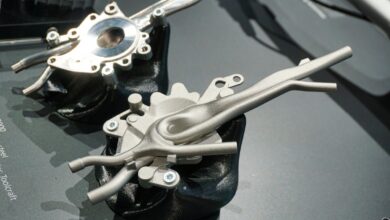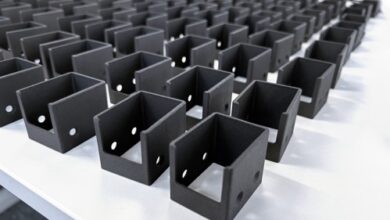Studenten TU Delft testen 3D geprinte nozzle voor raketmotor
Het DARE-team van de TU Delft heeft met succes een 3D geprinte nozzle getest. Deze nozzle is ontwikkeld voor de DHX-400 Nimbus motor van de Stratos III raket. Als materiaal hebben ze titanium gekozen. De statische test, waarbij temperaturen tot meer dan 3000 graden C worden bereikt, heeft in totaal 7 seconden geduurd.
Lichtgewicht titanium nozzle moet Stratos III tot 80 km hoogte brengen
Een groep studenten van de TU Delft werkt in het DARE-project (Delft Aerospace Rocket Engineering) aan de Stratos III. Met deze raket willen ze het Europees hoogterecord van studententeams verbeteren. Momenteel is dat in handen van een Duits team, dat ruim 32 km hoogte bereikt heeft met een zelf ontwikkelde en gebouwde raket. In Delft wil men daar bovenuit komen. De studenten mikken op 80 km maar stiekem hopen ze dat ze in een klap tot een hoogte van 100 km komen. Hiervoor is de nieuwe DHX-400 Nimbus motor een van de belangrijkste troeven van het team in Delft. Deze motor heeft in totaliteit een lengte van 1,7 meter en een stuwkracht van 15 kN (nominaal). Deze motor moet het uiteindelijk 28 seconden volhouden.
3D printen voor gewichtsbesparing
Omdat gewichtsbesparing belangrijk is, hebben de studenten de nozzle opnieuw ontwerpen. Dit keer met additive manufacturing als productietechnologie in hun achterhoofd. In de test die ze nu hebben gedaan, is de titanium verlenging van de nozzle 3 geprint. Deze productietechniek willen de studenten ook in de hele nozzle toepassen die uiteindelijk in de raketmotor van de Stratos 3 gebruikt zal worden. Het doel van de huidige test was om het 3D modellen die ze gebruiken voor het ontwerp van de lichtgewicht 3D geprinte titanium nozzle, te valideren. Dat is gelukt. Het DARE team onderzoekt momenteel ook of een coating op het 3D geprint titanium onderdeel de levensduur ervan kan verlengen. Dit zou met name een uitkomst zijn omdat het kostbare onderdeel dan voor meerdere testen opnieuw gebruikt kan worden.
In Made-in-Europe Magazine kun je een uitgebreide reportage over meerdere studententeams uit de Delftse Dreamhall lezen. Hierin doet Stijn Koehler uit de doeken hoe de studenten voordeel halen uit het ontwerpen in Catia.





